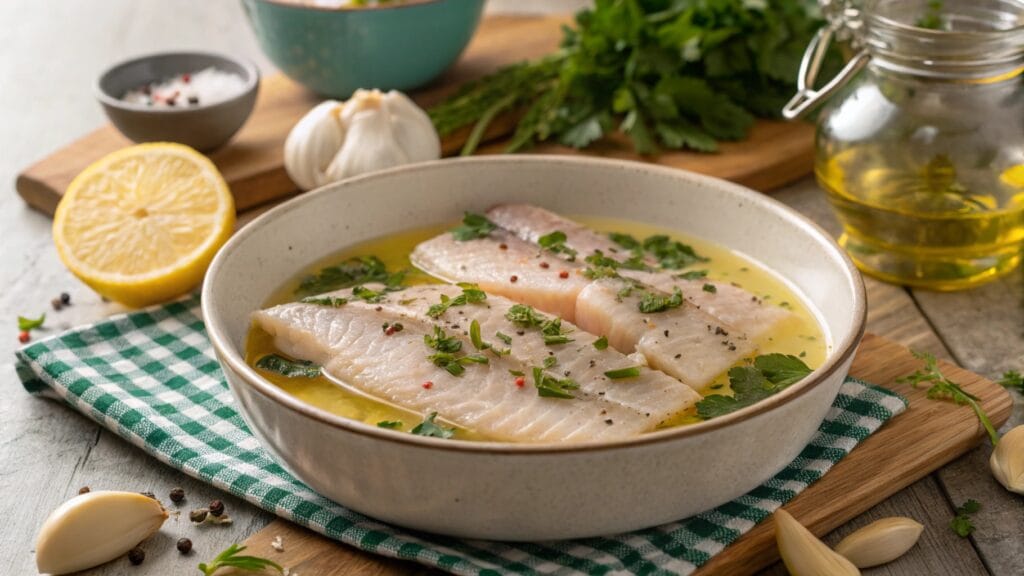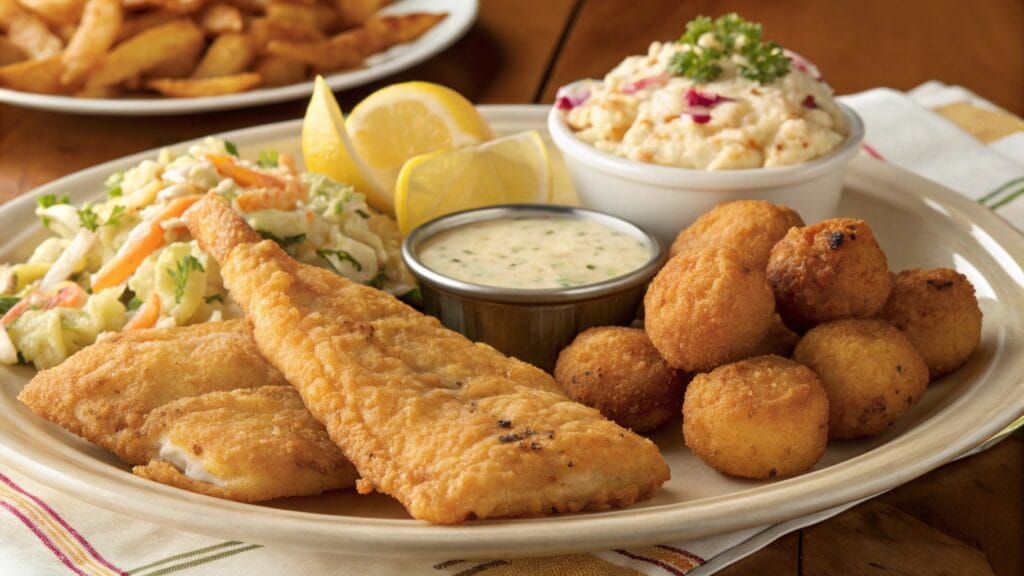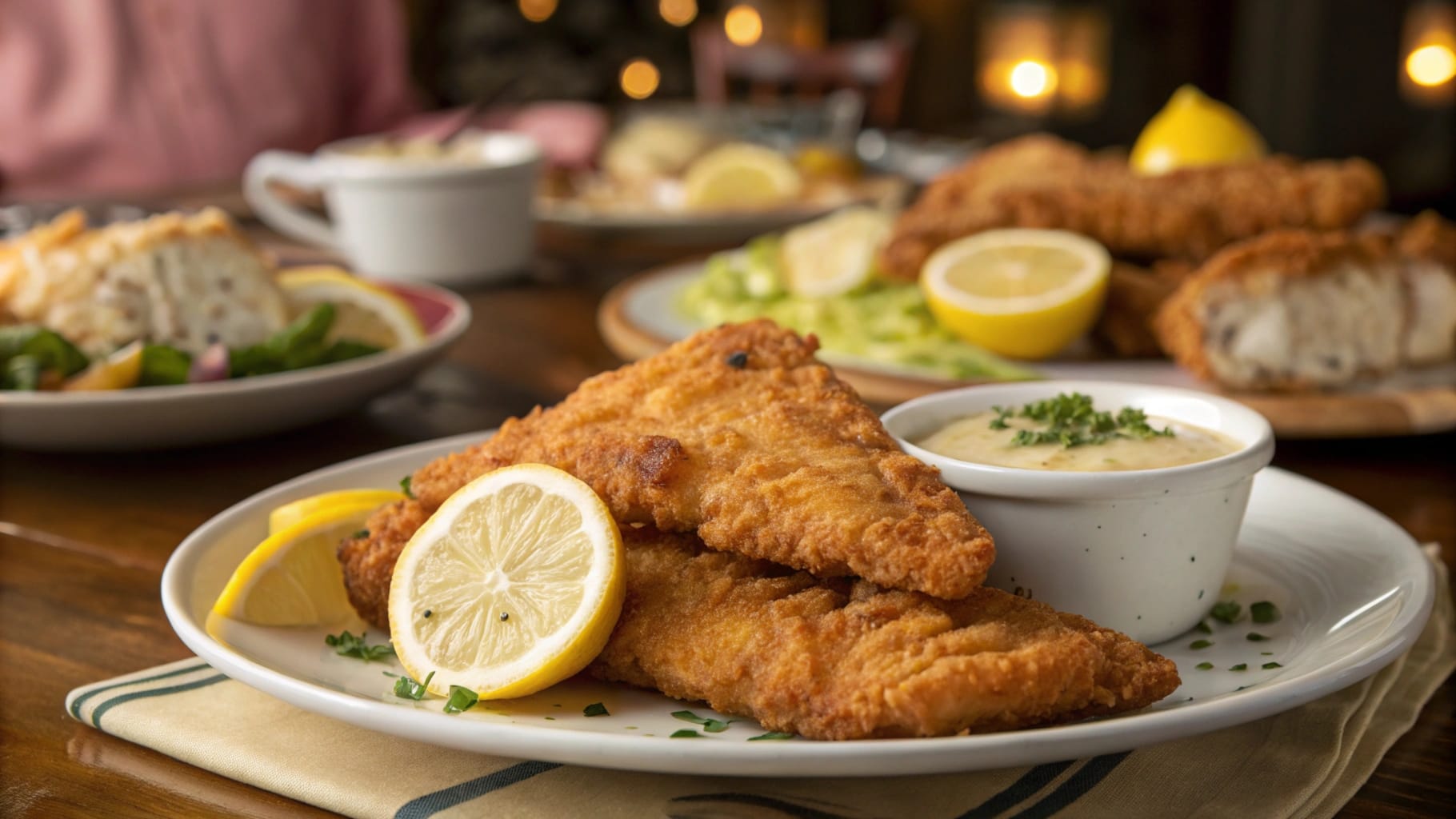How to Fry Fish: A Delicious Guide to Perfectly Crispy Fish Dishes
Frying fish is a timeless cooking technique that everyone should know. If you’ve ever wondered how to fry fish to achieve that perfectly crispy, golden crust, you’re in the right place. Whether you’re looking for a quick weeknight dinner or aiming to impress guests, mastering the art of frying fish is a skill that will elevate your meals. This guide will walk you through everything you need to know, from choosing the right fish to troubleshooting common frying mistakes. Let’s dive into the delicious world of perfectly fried fish!
Choosing the Best Fish for Frying: Top Picks for Flavor and Texture
Not all fish are created equal when it comes to frying. Some are perfect for getting that crispy coating, while others might leave you with a soggy mess. Here’s what to keep in mind when selecting the right fish for frying:
Firm Fish vs. Flaky Fish: What Works Best for Frying?
When frying, you want a fish that holds its shape and doesn’t fall apart in the hot oil. So, firm fish is your best bet. Fish like cod, haddock, and tilapia are fantastic choices because their flesh stays together, making them perfect for frying. On the other hand, flaky fish like trout and sole can be more delicate, so they might not fry as well without falling apart.
But don’t let that discourage you! If you’re craving a flakier fish, you can still make it work by handling it gently and being mindful of your frying technique.
Popular Fish Varieties for Frying
Some of the most popular fish varieties for frying include:
- Cod – A classic choice, thanks to its mild flavor and firm texture.
- Haddock – Similar to cod, haddock is slightly sweeter and great for frying.
- Tilapia – Light, mild, and perfect for getting that crispy golden crust.
- Catfish – A Southern favorite, catfish fries up crispy and delicious with a slightly earthy flavor.
- Flounder – Mild in flavor and slightly firmer than most flaky fish, this one fries up well too.
Fun Fact: Did you know that the type of fish you choose can also influence the flavor of your fried fish? Fish with stronger flavors (like mackerel) can give you a more pronounced taste, while milder fish will let the crispy coating and seasoning shine.
Essential Tools and Equipment for Frying Fish
Now that you’ve picked the perfect fish, let’s talk about the tools you need to fry it. While frying fish might sound simple, having the right equipment can make all the difference between a successful meal and one that falls flat.
Choosing the Right Frying Pan or Skillet
For frying fish, the pan you use matters more than you might think. A heavy-bottomed skillet or cast-iron pan is ideal because it retains heat well and distributes it evenly. If you’re using a non-stick pan, make sure it’s large enough to hold the fish without crowding, as overcrowding can lead to uneven cooking and soggy fish.
If you don’t have a cast-iron skillet, a deep-fryer is another great option, especially if you want to fry larger batches of fish at once.
Best Cooking Oils for Frying Fish
The oil you use will play a crucial role in the texture and flavor of your fried fish. The best oils for frying fish have a high smoke point (the temperature at which oil starts to break down and smoke). Here are a few great options:
- Vegetable oil – A common choice with a neutral flavor and high smoke point.
- Canola oil – Similar to vegetable oil, it’s light and doesn’t interfere with the fish’s flavor.
- Peanut oil – Great for high-heat cooking, it gives a slight nutty flavor that can complement the fish.
- Sunflower oil – Another high smoke point oil, perfect for crispy results.
Avoid oils like olive oil for frying fish because they have a lower smoke point and can burn easily, giving your fish an unpleasant flavor.
Preparing Fish for Frying: Key Steps to Follow
Now that you have your fish and equipment ready, it’s time to prep. The key to perfectly fried fish starts before it even touches the oil. Here’s how to get it right from the get-go.
Cleaning and Scaling Fish
If you’ve bought whole fish, you’ll need to clean and scale it. Don’t worry, it’s not as hard as it sounds! Use a fish scaler or the back of a knife to scrape off the scales. Start at the tail and move toward the head, working against the grain. Once scaled, use cold water to rinse the fish, making sure all the blood and guts are removed.
If you’ve bought pre-filleted fish, you’re in luck – no need to scale!
How to Cut Fish Fillets for Frying
If you’re working with whole fish, you’ll need to fillet it before frying. Use a sharp filleting knife and carefully cut along the spine, keeping the blade close to the bones. Don’t worry if your fillets aren’t perfect – they don’t have to be uniform, but try to keep them relatively even so they cook evenly.
Marinating Fish: Should You Do It?
Marinating fish before frying isn’t always necessary, but it can help add flavor and moisture to the fish. If you’re short on time, a simple marinade of lemon juice, garlic, and olive oil can go a long way in adding flavor.
Here’s a quick marinade recipe:
- 2 tbsp lemon juice
- 2 tbsp olive oil
- 1 garlic clove (minced)
- Salt and pepper to taste
Let the fish sit in the marinade for about 15-20 minutes. This gives the flavors time to seep into the flesh, making each bite more delicious. But be careful – don’t marinate for too long, or the acid in the lemon will start to break down the fish and make it mushy.

Nutrition Facts (Fried Fish)
Here’s a quick overview of the nutritional breakdown of a typical serving of fried fish:
| Nutrient | Amount (per serving) |
|---|---|
| Calories | 250-350 kcal |
| Protein | 20-25g |
| Carbohydrates | 10-15g |
| Fat | 15-20g |
| Fiber | 1-2g |
| Sodium | 200-300mg |
| Cholesterol | 35-50mg |
Note: These values may vary depending on the type of fish used and the cooking method.
Preparing Fish for Frying: Key Steps to Follow
Frying fish isn’t just about tossing it into hot oil and hoping for the best. You’ve got to prepare your fish properly to get that perfect crispy result. Here’s a step-by-step guide on how to prep your fish for frying.
Cleaning and Scaling Fish
If you’re using whole fish, the first step is cleaning and scaling it. While many fillets you buy from the store are already scaled and gutted, whole fish might need a little TLC. Here’s how to clean it:
- Scale the Fish: Use a fish scaler or the back of a knife to gently scrape off the scales. Be sure to do this over the sink or a large bowl to catch the scales.
- Gut the Fish: Cut the belly open and remove the internal organs, then rinse the fish thoroughly to ensure all the blood and remains are gone.
- Remove the Head: If you don’t want to fry the head, simply cut it off with a sharp knife.
If you’re using fillets, there’s no need to scale or gut the fish, but you might want to check for any bones before cooking.
How to Cut Fish Fillets for Frying
When it comes to frying, cutting the fish into even pieces is important for consistent cooking. Here’s how to do it:
- Fillet the Fish: If you’re working with a whole fish, use a sharp filleting knife to cut along the spine, following the bones to separate the flesh.
- Size Matters: For even cooking, try to cut your fillets into pieces that are about 1 inch thick. Larger pieces can take longer to cook, and smaller pieces may overcook quickly.
- Remove Skin (Optional): Some people like to fry fish with the skin on, as it helps keep the flesh moist. If you prefer a skinless fillet, use your knife to remove the skin before frying.
Marinating Fish: Should You Do It?
Marinating fish before frying is totally optional, but it can add a whole new layer of flavor. If you choose to marinate, aim for 15 to 30 minutes. Any longer, and you risk the fish becoming too soggy, which can interfere with the crispiness.
Some marinate ideas:
- Lemon and Garlic Marinade: A simple mix of lemon juice, garlic, salt, and pepper adds a tangy flavor that complements fried fish perfectly.
- Spicy Buttermilk Marinade: Buttermilk helps tenderize the fish, while a touch of hot sauce adds a bit of a kick.
- Herb Infusion: Fresh herbs like dill, thyme, or parsley can also be added to your marinade for an aromatic twist.
The Step-by-Step Process to Fry Fish to Perfection
Now comes the fun part—frying your fish! Follow these steps for a golden, crispy result every time.
Preparing the Coating: Flour, Cornmeal, or Batter?
The coating is where things get exciting. There are different ways to coat your fish for frying, each giving a unique texture and flavor.
- Flour Coating: This is the simplest and most common method. Season your fish fillets with salt and pepper, then dip them in a mixture of all-purpose flour. For extra crispiness, you can add a pinch of cornstarch to the flour.
- Cornmeal Coating: For a more Southern-style fried fish, cornmeal is a great option. It gives the fish a deliciously crunchy texture and a slightly sweet flavor.
- Batter Coating: A thicker batter, often made with flour, cornstarch, and egg, creates a crispy, golden shell that’s perfect for deep frying. This is the go-to choice for fish and chips!
You can also get creative and combine these coatings to create the perfect texture. For example, coat the fish in flour first, then dip it into a batter for an extra crispy layer.
How to Properly Heat Oil for Frying
Heating the oil correctly is crucial to frying fish properly. If the oil isn’t hot enough, your fish will absorb too much oil and become greasy. If the oil is too hot, the outside may burn while the inside remains raw. Here’s how to get it just right:
- Temperature Check: The ideal frying temperature is between 350°F to 375°F (175°C to 190°C). You can use a cooking thermometer to ensure the oil is at the right temperature.
- Test with a Small Piece: If you don’t have a thermometer, you can test the oil by dropping a small piece of bread into the pan. If it browns in about 60 seconds, the oil is ready. If it burns too quickly, lower the heat; if it sinks and doesn’t brown, raise the heat.
Frying Fish: Time, Temperature, and Technique
Once your oil is hot and your fish is coated, it’s time to fry! Here’s how to do it perfectly:
- Place Fish in the Oil Carefully: Gently drop the fish into the hot oil, one piece at a time. Don’t overcrowd the pan, as this lowers the temperature of the oil and can cause uneven cooking.
- Cook the Fish in Batches: If you have a lot of fish, it’s best to fry in batches. This ensures each piece gets enough space to cook properly and crisp up.
- Fry Until Golden Brown: Cook each piece for about 3 to 4 minutes per side, or until the coating is golden brown and the fish flakes easily with a fork. The fish should be cooked through but still juicy inside.
- Drain Excess Oil: Once your fish is done, use tongs or a slotted spoon to remove it from the oil. Place it on a plate lined with paper towels to absorb any excess oil.
Serving Suggestions: How to Pair Your Fried Fish
Once your fish is fried to perfection, it’s time to serve it up! Fried fish pairs wonderfully with a variety of sides and sauces. Here are some ideas:
- Classic Sides: French fries, coleslaw, or cornbread are always great options for a fried fish meal.
- Sauces and Dips: Try tartar sauce, cocktail sauce, or a squeeze of fresh lemon for added flavor.
Common Problems When Frying Fish and How to Solve Them
Frying fish can sometimes be tricky. But don’t worry, we’ve all been there! Here are some common problems and how to solve them.
Why is My Fish Soggy After Frying?
Soggy fish is often the result of the oil being too cool or the fish being too wet. Make sure to pat your fish dry with a paper towel before frying, and ensure that the oil is hot enough (350°F to 375°F). If you’re using a batter, avoid letting the fish sit in the batter for too long before frying.
How to Avoid Fish Sticking to the Pan
To prevent sticking, use a non-stick skillet or make sure your pan is well-heated before adding the oil. Also, avoid overcrowding the pan, as this can cause the fish to stick together.
Fish Burning or Overcooking: How to Prevent It
Overcooking or burning fish is usually a sign that the oil is too hot or the fish is cooked for too long. Make sure to cook your fish in batches and keep an eye on the temperature of the oil. Also, use a thermometer to help maintain a consistent heat.
Now that you know how to prepare and fry fish to perfection, you’re on your way to becoming a pro! Stay tuned for the next part, where we’ll dive into tips on achieving the perfect crispy crust, healthier frying options, and cultural variations of fried fish around the world.

Conclusion: Mastering the Art of Frying Fish
Frying fish may seem like a simple task, but it’s one of those cooking skills that, when perfected, can elevate your meals to a whole new level. The crispy crust, the delicate, flaky interior, and the savory aroma—there’s just nothing quite like it. Whether you’re frying up a quick weeknight dinner or preparing a special dish for a gathering, knowing how to fry fish properly can make all the difference.
By following the steps and tips shared throughout this guide, you’ll be able to achieve the perfect fried fish every time. And don’t forget—there’s always room for creativity! Play around with different fish varieties, coatings, and seasonings to find your personal signature fried fish recipe.
Final Tips for Perfect Fried Fish Every Time
- Don’t Overcrowd the Pan: When frying, make sure to give each piece of fish enough space in the pan. Crowding the pan can lower the oil temperature and result in soggy fish. Fry in batches if necessary.
- Maintain the Right Oil Temperature: The oil should stay hot throughout the cooking process, between 350°F to 375°F (175°C to 190°C). If the oil cools down too much, the fish will absorb more oil, becoming greasy instead of crispy.
- Use Paper Towels: Once your fish is done, place it on a plate lined with paper towels to absorb any excess oil. This will help keep the crispy texture intact.
- Experiment with Coatings: While flour and cornmeal are classics, don’t hesitate to try panko breadcrumbs or even crushed crackers for an extra crunch. Each coating gives a different texture and flavor.
- Resting is Key: Let your fish rest for a few minutes after frying. This helps the coating set and enhances the overall texture. Plus, it gives you time to get your sides ready!
Why Frying Fish Is a Skill Worth Perfecting
Frying fish might seem like a straightforward cooking method, but it’s one of those skills that, once perfected, can be incredibly rewarding. Here are a few reasons why you should take the time to master this technique:
- Versatility: Fried fish can be served in so many ways—from classic fish and chips to fish tacos or even as a topping for a salad. Mastering the fry opens up endless meal possibilities.
- Impressive Dish: Knowing how to fry fish perfectly is a showstopper in the kitchen. Whether you’re cooking for family, friends, or guests, a perfectly fried fish dish will always impress.
- Quick and Easy: With the right technique, frying fish is quick and easy. You can go from raw to crispy in just a few minutes, making it a go-to weeknight meal for busy people. You don’t need a ton of prep time, and the results are always delicious.
- Affordable: Fish is often more affordable than meat, especially if you go with options like tilapia or catfish. By learning how to fry fish, you can create gourmet-quality dishes without breaking the bank.
- Healthy (When Done Right): Frying fish, especially if you opt for healthier oils like canola or peanut oil, can still be part of a balanced diet. Plus, fried fish is a fantastic source of protein and omega-3 fatty acids.
So, there you have it—everything you need to know about frying fish to perfection. Whether you’re just starting out or looking to refine your technique, remember that practice makes perfect. Don’t be afraid to experiment with different types of fish, seasonings, and coatings to create your ideal fried fish dish. Once you master it, you’ll be able to serve up crispy, flavorful fried fish whenever the craving strikes.
Now, go ahead, heat up that oil, and start frying up something delicious. Bon appétit!
Frequently Asked Questions (FAQ)
1. How to Make Fried Fish?
Making fried fish is simpler than you might think. Start by selecting your fish (like cod, tilapia, or catfish). Clean and cut it into fillets, then season it to your taste. Next, coat the fish in flour, cornmeal, or batter. Heat oil in a skillet or deep fryer to 350°F (175°C), then fry the fish for 3-5 minutes per side, depending on thickness. Once golden and crispy, drain excess oil on paper towels, and serve with your favorite sides!
2. What’s the Best Recipe for Fried Fish?
The best recipe for fried fish is one that results in a crispy crust and tender fish. For a classic, go with a simple flour and cornmeal coating, seasoned with salt, pepper, and garlic powder. Add a pinch of paprika for extra flavor. Fry your fish at the right temperature (350°F to 375°F) to ensure it’s crispy on the outside and flaky on the inside. Serve with coleslaw, fries, or cornbread to complete the meal.
3. What’s the Best Fried Fish Recipe Ever?
The best fried fish recipe ever combines the perfect balance of crispy coating and juicy fish. Start with catfish or cod, dip them in buttermilk, and then coat with a mix of flour, cornmeal, garlic powder, and paprika. Fry until golden brown, then serve with a tangy lemon dipping sauce or tartar sauce. This recipe is guaranteed to impress, with that crunchy exterior and flaky interior that everyone loves!
4. What Are Some Southern Fried Fish Recipes?
Southern fried fish recipes are all about big flavors and crispy coatings. The traditional Southern-style fish is made with cornmeal and flour, seasoned generously with salt, pepper, and cayenne for a little kick. You can add garlic, onion powder, and a touch of sugar for balance. Once battered, the fish is deep-fried until golden brown and crispy. Serve it with hushpuppies, coleslaw, and a squeeze of lemon for a true Southern feast.
5. How Do I Prevent My Fried Fish From Getting Soggy?
To prevent soggy fried fish, make sure your oil is hot enough (around 350°F to 375°F) before adding the fish. This ensures the coating crisps up immediately and prevents the fish from soaking up too much oil. Don’t overcrowd the pan, as this lowers the oil temperature and can lead to soggy fish. After frying, drain your fish on paper towels to absorb excess oil, and serve immediately for the best crispy texture.

